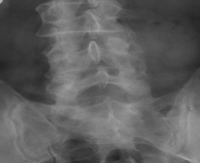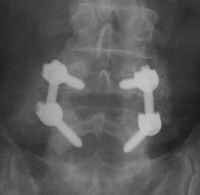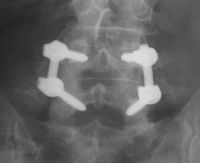No complications reported using rhBMP-2 in lumbar fusions with dural tears
At 2 postoperative years, patients with and without dural tears showed neurologic improvements with recombinant human BMP-2 use.
ORLANDO, Fla. — Investigators at the Norton Leatherman Spine Center in Louisville, Ky., confirmed in a comparative human study what some preclinical studies have only suggested before now, that using a recombinant human bone morphogenetic protein to foster lumbar fusion in cases where dural tears occur does not affect short-term recovery from the event.
“A repaired dural tear probably is not a contraindication to using BMP [bone morphogenetic protein] in a posterolateral setting,” Steven D. Glassman, MD, said.
At the 2010 Annual Meeting of the North American Spine Society, he presented the results of using recombinant human BMP-2 (Infuse, Medtronic) in 58 consecutive patients who had dural tears that surgeons repaired during posterolateral lumbar fusion surgery.
The study’s results apply only to posterolateral fusion cases where the tears were repaired, Glassman noted. “If I had a dural tear I couldn’t repair in a satisfactory manner, I would have concerns about whether BMP should be used in that case,” he said.
Matched groups analyzed
In their propensity score matched case-control study, Glassman and colleagues identified 58 patients who had dural tears among 1,037 consecutive patients at their institution undergoing decompression and posterolateral lumbar fusion using rhBMP-2.
|
|
|
|
|
AP radiographs of a patient who underwent posterolateral fusion with rhBMP-2 with Mastergraft (Medtronic) granules as a bulking agent: (left) preoperative, (center) 1-year postoperative, (right) 2-years postoperative. Images: Glassman SD |
||
“We propensity matched that group against a group that didn’t have dural tears that were controlled for all the other factors that might be relevant,” according to Glassman, who explained he and his colleagues subsequently analyzed the groups’ 1- and 2-year outcomes, looking particularly closely at the Oswestry Disability Index (ODI) and leg pain results.
Improvement through 2 years
Investigators noticed few differences between the groups at any time point, based on the study’s findings.
The duration of surgery, however, was longer in the group with the dural tears, likely due to the time it took to make the repairs, Glassman said.
“We had ODI improvement in both groups. It looked the same. We had leg pain improvement and it looked statistically the same and that was true at both 1 year and 2 years,” he said.
Repairs of the dural tears studied were augmented with a tissue sealant in 29 (57%) of the cases, Glassman explained. “Given that scenario, we did not seem to see any effect on neurologic function or recovery with these posterolateral BMP cases.”
Using rhBMP-2 for this indication is not approved by the FDA. – by Susan M. Rapp
Reference:
- Glassman SD, Gum JL, Crawford CH, et al. Complications with rhBMP-2 in posterolateral spine fusion associated with a dural tear. Paper #16. Presented at the 2010 Annual Meeting of the North American Spine Society. Oct. 5-9, 2010. Orlando, Fla.

- Steven D. Glassman, MD, can be reached at the Department of Orthopaedic Surgery, University of Louisville School of Medicine, 210 East Gray St., Suite 1003, Louisville, KY 40202; 502-584-7525; e-mail: sdg12345@aol.com.
Disclosure: Glassman receives royalties, consulting fees, trip/travel support and research support from Medtronic.



